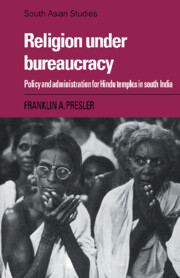Book contents
- Frontmatter
- Contents
- Dedication
- Preface
- Notes on sources, abbreviations and transliteration
- Map
- 1 Introduction: studying religion-state relations
- 2 The temple connection in the nineteenth century
- 3 Governance: the necessity for order
- 4 Governance: trustees and the courts
- 5 Economy: the problem of controlling land
- 6 Economy: the temple's weakness as landlord
- 7 Religion: purifying and organizing Hinduism
- 8 Religion: controlling the priesthood
- 9 Conclusion
- Bibliography
- Index
7 - Religion: purifying and organizing Hinduism
Published online by Cambridge University Press: 03 October 2009
- Frontmatter
- Contents
- Dedication
- Preface
- Notes on sources, abbreviations and transliteration
- Map
- 1 Introduction: studying religion-state relations
- 2 The temple connection in the nineteenth century
- 3 Governance: the necessity for order
- 4 Governance: trustees and the courts
- 5 Economy: the problem of controlling land
- 6 Economy: the temple's weakness as landlord
- 7 Religion: purifying and organizing Hinduism
- 8 Religion: controlling the priesthood
- 9 Conclusion
- Bibliography
- Index
Summary
Religion has never been very far from the eye of the modern Indian state. For over a century, statutes have attacked such varied practices as caste disabilities, untouchability, the age of consent, and restricted temple entry. Though usually described as social rather than religious reforms, their impact on religion, especially on Hindu practices, has nonetheless been profound.
It is therefore no surprise to find that temple religion is affected by HRCE administration. There is something of a contradiction involved, to be sure, since the principles of Indian secularism would seem to imply that government agencies should not tamper with, or “interfere with,” religion. The HRCE Act, indeed, specifically restricts administration to financial and nonreligious matters. But even the most scrupulous secularist would find that supervising temple governance and economy inevitably affects temple religion. “Noninterference,” a concept with a long and distinguished history, is a good slogan to legitimate the HRCE, but it is an inaccurate description of actual practice.
What is unexpected and striking is the detail, depth and extent of the HRCE's impact. The department's efforts to transform religion are explicit, elaborate and systematic. It operates on a wide range of religious fronts, some of which have major consequences.
The constant focus which governments give temple religion suggests that religious policy can serve very definite political ends. Certainly publicity about temple religious practices can be diversionary, drawing public attention away from other, often more pressing and controversial areas. Governments have also found that religious policy can be useful in building political alliances and, especially, that it can make a broad ideological appeal.
- Type
- Chapter
- Information
- Religion under BureaucracyPolicy and Administration for Hindu Temples in South India, pp. 110 - 133Publisher: Cambridge University PressPrint publication year: 1988



